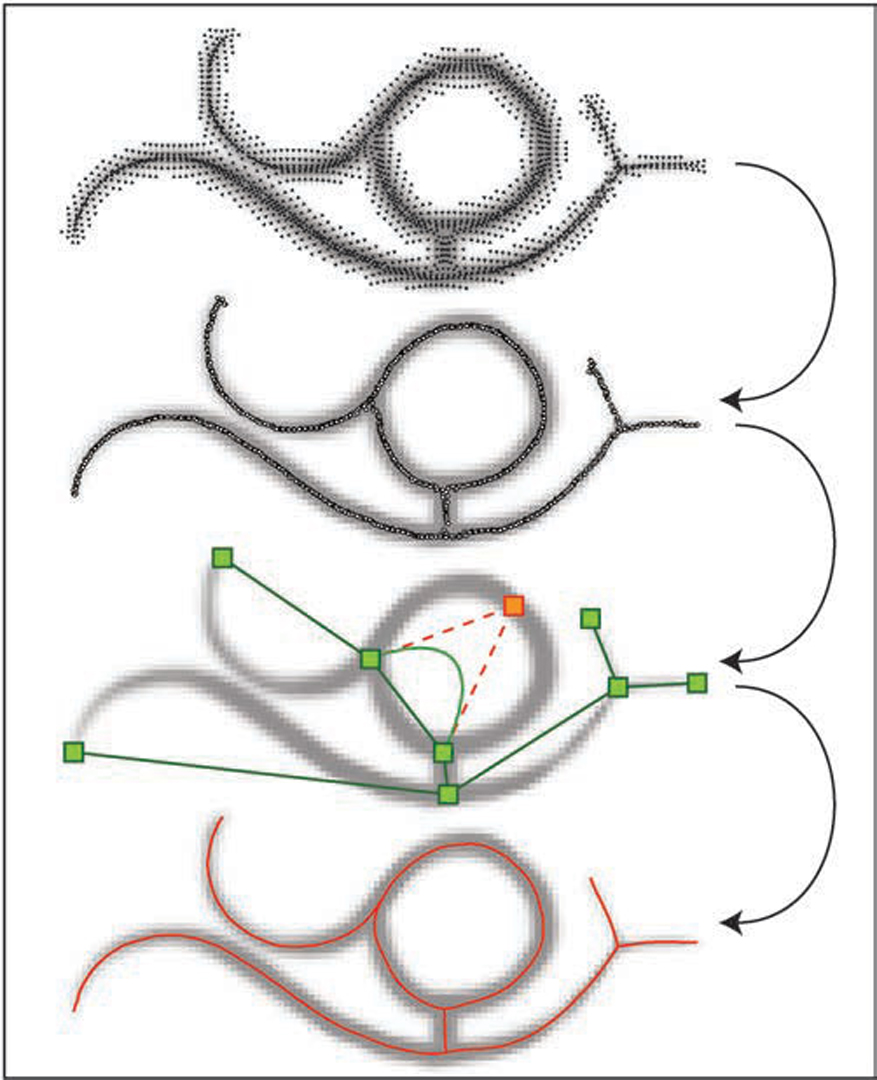“Topology‐Driven Vectorization of Clean Line Drawings” by Noris, Sorkine-Hornung, Sumner, Simmons and Gross
Conference:
Type:
Title:
- Topology‐Driven Vectorization of Clean Line Drawings
Session/Category Title: Line Drawing
Presenter(s)/Author(s):
Moderator(s):
Abstract:
Vectorization provides a link between raster scans of pencil-and-paper drawings and modern digital processing algorithms that require accurate vector representations. Even when input drawings are comprised of clean, crisp lines, inherent ambiguities near junctions make vectorization deceptively difficult. As a consequence, current vectorization approaches often fail to faithfully capture the junctions of drawn strokes. We propose a vectorization algorithm specialized for clean line drawings that analyzes the drawing’s topology in order to overcome junction ambiguities. A gradient-based pixel clustering technique facilitates topology computation. This topological information is exploited during centerline extraction by a new “reverse drawing” procedure that reconstructs all possible drawing states prior to the creation of a junction and then selects the most likely stroke configuration. For cases where the automatic result does not match the artist’s interpretation, our drawing analysis enables an efficient user interface to easily adjust the junction location. We demonstrate results on professional examples and evaluate the vectorization quality with quantitative comparison to hand-traced centerlines as well as the results of leading commercial algorithms.
References:
- Adobe, 2010. Illustrator. http://www.adobe.com/.
- Bartolo, A., Camilleri, K. P., Fabri, S. G. Borg, J. C., and Farrugia, P. J. 2007. Scribbles to vectors: Preparation of scribble drawings for CAD interpretation. In Proceedings of the Conference on Sketch Based Interfaces and Modeling. 123–130.
- Chang, H.-H. and Yan, H. 1998. Vectorization of hand-drawn image using piecewise cubic bezier curves fitting. Pattern Recogn. 31, 11, 1747–1755.
- Chen, J. S., Huertas, A., and Medioni, G. 1987. Fast convolution with laplacian-of-gaussian masks. IEEE Trans. Pattern Anal. Mach. Intell. 9, 584–590.
- Cornea, N. D., Silver, D., and Min, P. 2007. Curve-Skeleton properties, applications and algorithms. IEEE Trans. Vis. Comput. Graph. 13, 3, 530–548.
- Freeman, H. 1974. Computer processing of line-drawing images. ACM Comput. Surv. 6, 1, 57–97.
- Hilaire, X. and Tombre, K. 2006. Robust and accurate vectorization of line drawings. IEEE Trans. Pattern Anal. Mach. Intell. 28, 6, 890–904.
- Janssen, R. D. T. and Vossepoel, A. M. 1997. Adaptive vectorization of line drawing images. Comput. Vis. Image Understand. 65, 1, 38–56.
- Kirbas, C. and Quek, F. K. H. 2000. A review of vessel extraction techniques and algorithms. ACM Comput. Surv. 36, 81–121.
- Kleinberg, J. and Tardos, E. 2005. Algorithm Design. Addison-Wesley Longman Publishing Co., Inc.
- Lakshmi, J. K. and Punithavalli, M. 2009. A survey on skeletons in digital image processing. In Proceedings of the International Conference on Digital Image Processing. IEEE Computer Society, Los Alamitos, CA, 260–269.
- Lam, L., Lee, S.-W., and Suen, C. Y. 1992. Thinning methodologies — a comprehensive survey. IEEE Trans. Pattern Anal. Mach. Intell. 14, 9, 869–885.
- Lecot, G. and Levy, B. 2006. ARDECO: Automatic region Detection and Conversion. In Proceedings of the Eurographics Symposium on Rendering (EGSR ’06). 349–360.
- Orzan, A., Bousseau, A., Winnemoller, H., Barla, P., Thollot, J., et al. 2008. Diffusion curves: A vector representation for smooth-shaded images. ACM Trans. Graph. 27, 3.
- Sisoft.Net, 2010. Wintopo. http://wintopo.com/.
- Sun, J., Liang, L., Wen, F., and Shum, H.-Y. 2007. Image vectorization using optimized gradient meshes. ACM Trans. Graph. 26, 3, 11.
- Sykora, D., Burianek, J., and Zara, J. 2005. Video codec for classical cartoon animations with hardware accelerated playback. In Proceedings of the International Symposium on Visual Computing. 43– 50.
- ToonBoom, 2010. Harmony. http://www.toonboom.com/.
- Whited, B., Rossignac, J., Slabaugh, G., Fang, T., and Unal, G. 2009. Pearling: Stroke segmentation with crusted pearl strings. Pattern Recogn Image Anal. 19, 2, 277–283.
- Whited, B., Noris, G., Simmons, M., Sumner, R. W., Gross, M., et al. 2010. BetweenIT: An interactive tool for tight inbetweening. Comput. Graph. Forum 29, 2.
- Xia, T., Liao, B., and Yu, Y. 2009. Patch-based image vectorization with automatic curvelinear feature alignment. ACM Trans. Graph. 28, 5, 1– 10.
- Zhang, S.-H., Chen, T., Zhang, Y.-F., Hu, S.-M., and Martin, R. R. 2009. Vectorizing cartoon animations. IEEE Trans. Vis. Comput. Graph. 15, 4, 618–629.
- Zou, J. J., and Yan, H. 2001. Cartoon image vectorization based on shape subdivision. In Proceedings of the International Conference on Computer Graphics. 225–231.




